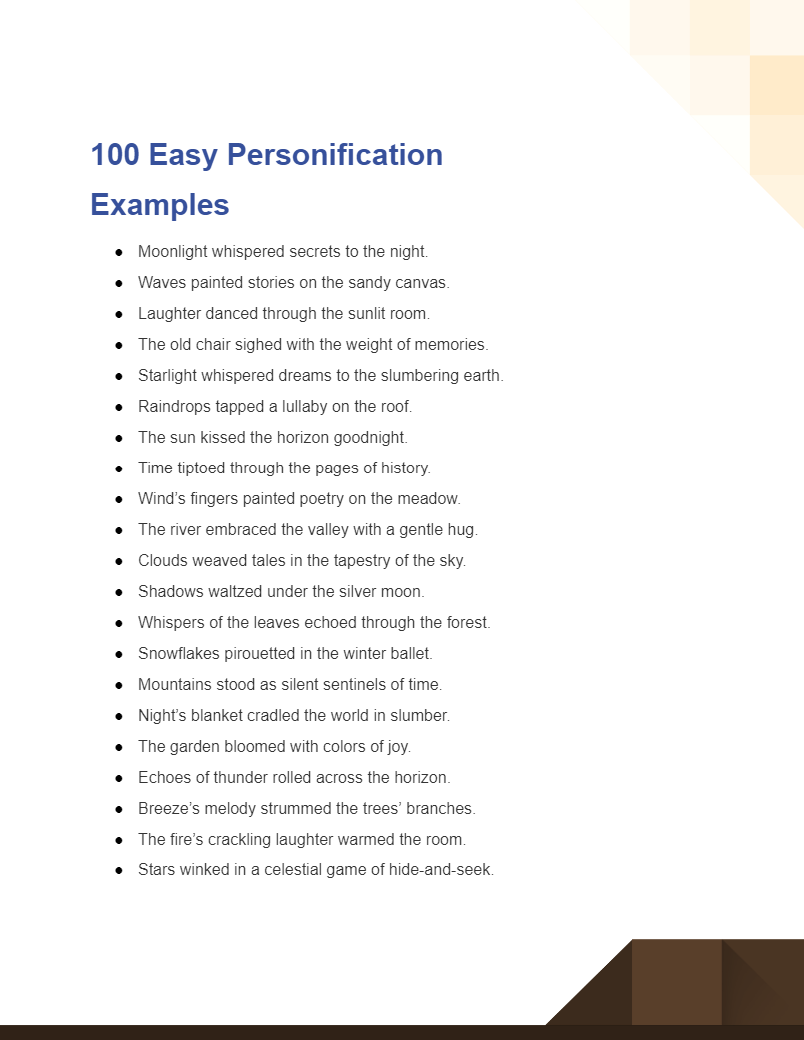99+ Easy Personification Examples
Personification, the art of imbuing lifeless entities with human-like qualities, is a literary device that enriches narratives and deepens readers’ connections. While it may sound sophisticated, it’s a technique we’ve all encountered, often without realizing. From childhood tales to poetic verses, personification paints vivid imagery, making abstract concepts palpable. This guide simplifies personification examples, offering easy examples and actionable writing tips, ensuring even beginners can harness this tool with flair and finesse.
What is an Easy Personification? – Definition
An easy personification is a literary device that attributes human-like qualities or actions to non-human objects, ideas, or elements in a simple and straightforward manner. It’s a creative tool that adds depth and relatability to writing by making inanimate things come alive with human traits, enabling readers to connect more deeply with the narrative.
What is the Best Example of Easy Personification?
A stellar example of easy personification can be found in the phrase “The flowers danced in the gentle breeze.” Here, the flowers are given the human-like action of dancing, making the scene come alive and infusing it with a sense of joy and movement. This uncomplicated personification not only paints a vivid picture but also evokes a sense of liveliness in the reader’s imagination.
100 Easy Personification Examples

Easy personification examples bring the magic of human attributes to lifeless things, making them relatable and vibrant. These simple yet effective literary devices enhance writing by creating vivid imagery and emotional resonance.
- Moonlight whispered secrets to the night.
- Waves painted stories on the sandy canvas.
- Laughter danced through the sunlit room.
- The old chair sighed with the weight of memories.
- Starlight whispered dreams to the slumbering earth.
- Raindrops tapped a lullaby on the roof.
- The sun kissed the horizon goodnight.
- Time tiptoed through the pages of history.
- Wind’s fingers painted poetry on the meadow.
- The river embraced the valley with a gentle hug.
- Clouds weaved tales in the tapestry of the sky.
- Shadows waltzed under the silver moon.
- Whispers of the leaves echoed through the forest.
- Snowflakes pirouetted in the winter ballet.
- Mountains stood as silent sentinels of time.
- Night’s blanket cradled the world in slumber.
- The garden bloomed with colors of joy.
- Echoes of thunder rolled across the horizon.
- Breeze’s melody strummed the trees’ branches.
- The fire’s crackling laughter warmed the room.
- Stars winked in a celestial game of hide-and-seek.
- Raindrops tapped their Morse code on the window.
- Dawn’s fingers painted the sky in hues of gold.
- Reflections of the sun danced on the water’s surface.
- Time’s footsteps left echoes in the corridors of memory.
- The city’s heartbeat pulsed through the streets.
- The road stretched its arms, beckoning to the horizon.
- Night’s silence whispered tales of dreams.
- The field’s canvas painted in shades of green.
- River’s song serenaded the stones.
- Leaves’ whispers carried secrets of seasons.
- The moon’s glow kissed the earth’s cheek.
- Shadows played a game of tag on the wall.
- Dreams wrapped the night sky in a velvet cloak.
- The wind’s laughter swirled among the leaves.
- Stars sprinkled their magic across the sky.
- The rain’s touch was a soothing lullaby.
- The mountain’s wisdom echoed through ages.
- The ocean’s waves whispered ancient stories.
- The forest’s heart beat in the rustling leaves.
- The sun’s embrace warmed the earth’s soul.
- The moon’s glow lit up the night’s secrets.
- Raindrops’ dance painted music on the roof.
- The wind’s caress brushed the flowers’ cheeks.
- The stars’ twinkle was a celestial conversation.
- Shadows’ fingers painted art on the wall.
- Dreams’ whispers echoed in the still night.
- The river’s laughter echoed in the valley.
- The sun’s kiss woke the world with a smile.
- Clouds’ embrace blanketed the sky in comfort.
- Stars’ glimmer was a galaxy’s wink.
- Waves’ embrace whispered tales to the shore.
- The city’s pulse echoed through the streets.
- The road’s invitation led to the unknown.
- Night’s song echoed in the quiet.
- The field’s canvas held nature’s brushstrokes.
- River’s serenade lulled the stones to sleep.
- Leaves’ confessions rustled in the breeze.
- The moon’s glow embraced the night’s canvas.
- Shadows’ dance painted stories on the wall.
- Dreams’ whispers lingered in the night’s air.
- Wind’s fingers composed a symphony in the trees.
- Stars’ constellations told tales of wonder.
- Raindrops’ symphony played on the rooftop.
- The mountain’s majesty whispered through ages.
- Ocean’s waves whispered secrets to the shore.
- Forest’s heartbeat pulsed in the rustling leaves.
- Sun’s warmth kissed the earth’s cheek.
- Moon’s glow adorned the night’s tapestry.
- Raindrops’ rhythm tapped on the window.
- Wind’s laughter rustled the leaves’ laughter.
- Stars’ shimmer was a cosmic conversation.
- Waves’ ballet enchanted the waiting shore.
- The city’s heartbeat echoed through the streets.
- The road’s promise led to uncharted paths.
- Night’s whispers carried secrets on the breeze.
- The field’s palette painted a masterpiece.
- River’s melody soothed the stones to slumber.
- Leaves’ murmurs carried tales in the breeze.
- The moon’s glow embraced the night’s canvas.
- Shadows’ play painted tales on the wall.
- Dreams’ embrace whispered hopes in the dark.
- Wind’s embrace swayed trees in a dance.
- Stars’ sparks ignited the celestial realm.
- Raindrops’ patter was a rooftop symphony.
- The mountain’s stature echoed through time.
- The ocean’s waves told stories to the sands.
- Forest’s rhythm pulsed in the heart of leaves.
- Sun’s rays painted warmth on the earth.
- Moon’s radiance adorned the night’s splendor.
- Raindrops’ rhythm composed a rooftop song.
- Wind’s whisper carried secrets through branches.
- Stars’ constellations formed tales of old.
- Waves’ embrace embraced the waiting shore.
- The city’s rhythm echoed through the streets.
- The road’s journey led to adventures unknown.
- Night’s embrace cradled dreams in the dark.
- The field’s canvas held a masterpiece of nature.
- River’s melody lulled stones into dreams.
- Leaves’ rustle carried secrets on the wind.
Easy Personification Examples for Kids
These personification examples for kids are designed to resonate with children. They showcase how simple personification can make everyday elements come to life, like the sun waking up or flowers dancing in the breeze.
- The sun woke up and peeked through the curtains.
- The raindrops tapped on the window like a friendly visitor.
- The stars blinked in the sky, playing hide-and-seek.
- The flowers danced in the breeze, wearing colorful dresses.
- The trees whispered secrets to each other in the wind.
Easy Personification Examples for School
Here, we’ve given examples that are related to school environments. I’ve personified objects like lockers, chalk, textbooks, and the school bell, which helps create a playful and relatable atmosphere for students.
- The school hallway buzzed with excitement as lockers chatted.
- The chalk eagerly leapt onto the blackboard, creating equations.
- The textbooks sat patiently, waiting for eager minds to explore.
- The school bell chimed, its call reaching every corner.
- The library shelves held stories that beckoned with open arms.
Easy Personification Examples for Students
These examples target a broader student audience. They involve familiar items like pencils, laptops, notebooks, and classroom clocks, making the concept of personification relatable to students’ daily lives.
- The pencil jumped at the chance to tell stories on paper.
- The laptop screen blinked, inviting creative ideas to flow.
- The notebook eagerly absorbed thoughts like a sponge.
- The classroom door welcomed students with open arms.
- The clock on the wall counted minutes like a faithful friend.
Easy Personification Examples in Literature
This personification in literature section focuses on examples you might encounter in literature. It takes more abstract elements like wind, rain, mountains, stars, and ocean waves and gives them human-like qualities to create vivid imagery.
- The wind whispered secrets through the pages of the book.
- The rain painted the town silver with its gentle touch.
- The mountains stood tall, guarding the secrets of the valley.
- The stars twinkled like diamonds on the velvet canvas.
- The ocean waves sang lullabies to the moonlit shore.
Easy Personification Sentence Examples
In this set of examples, I’ve provided simple personification sentences that demonstrate personification. These sentences give life to various elements, such as the moon smiling, fire crackling, leaves rustling and giggling, shadows dancing, and a river whispering.
- The moon smiled down on the sleepy village.
- The fire crackled and shared stories with the night.
- The leaves rustled and giggled in the playful breeze.
- The shadows danced on the wall, telling tales of adventure.
- The river whispered its journey to the curious stones.
How to Write Easy Personification
Personification brings life to the inanimate, making writing vibrant and relatable. Here’s a step-by-step guide on crafting easy personification that captivates:
1. Choose Your Subject: Select an object, element, or idea to personify. It can be something as simple as the wind, rain, or even everyday items like a chair or a clock.
2. Identify Human Traits: Determine the human-like qualities or actions you want to attribute to your chosen subject. Think about emotions, movements, and behaviors.
3. Create Vivid Imagery: Craft a sentence that paints a clear mental image. Incorporate sensory details to immerse readers in the scene. For example, “The wind whispered secrets through the trees.”
4. Use Metaphorical Language: Employ metaphors to enhance the personification. Compare the subject to something human-related to make the connection stronger. For instance, “The stars danced in the night sky.”
5. Stay Simple and Clear: Choose uncomplicated language that’s easy to understand, especially if you’re writing for children or beginners. Keep the personification relatable and straightforward.
6. Convey Emotion: Utilize personification to evoke emotions. By attributing feelings to non-human things, you make the writing more emotionally resonant. For example, “The sun smiled down on the city.”
Tips to Writing an Easy Personification
Mastering easy personification requires finesse and imagination. Here are some tips to make your personification shine:
1. Observe the World: Pay attention to everyday life and the behavior of objects around you. This will provide inspiration for personification ideas.
2. Start Small: Begin with simple objects before moving on to more complex concepts. This will help you grasp the technique and gradually build your skills.
3. Use Analogies: Analogies can make personification more relatable. Compare the subject to something your audience is familiar with to strengthen the connection.
4. Be Playful: Don’t be afraid to inject humor or playfulness into your personification. It can add an entertaining element to your writing.
5. Appeal to the Senses: Incorporate sensory details like sights, sounds, and textures to create a vivid experience for readers.
6. Edit and Refine: After writing, read your personification aloud to ensure it flows smoothly. Edit for clarity and coherence, and refine your metaphors if needed.
7. Connect Emotionally: The key to effective personification is evoking emotions. Think about the feelings you want to convey and use personification to amplify them.
8. Practice Regularly: Like any skill, practice is essential. Challenge yourself with different subjects and scenarios to improve your personification skills over time.
Remember, personification is a powerful tool that adds depth and creativity to writing. By following these steps and tips, you’ll be able to write easy personification that engages readers and brings your words to life.


